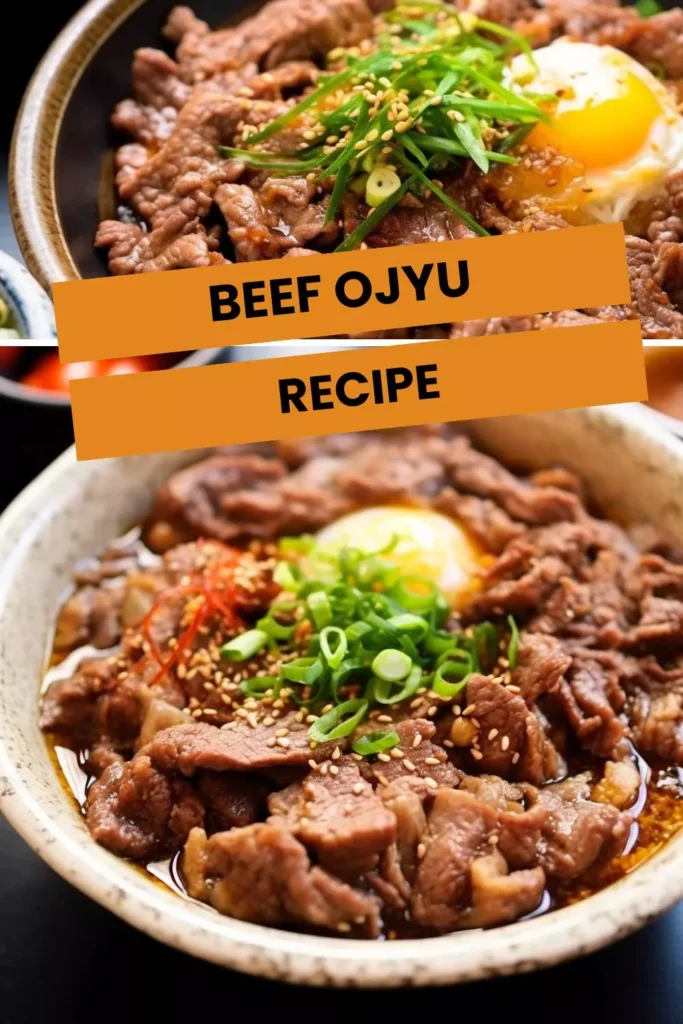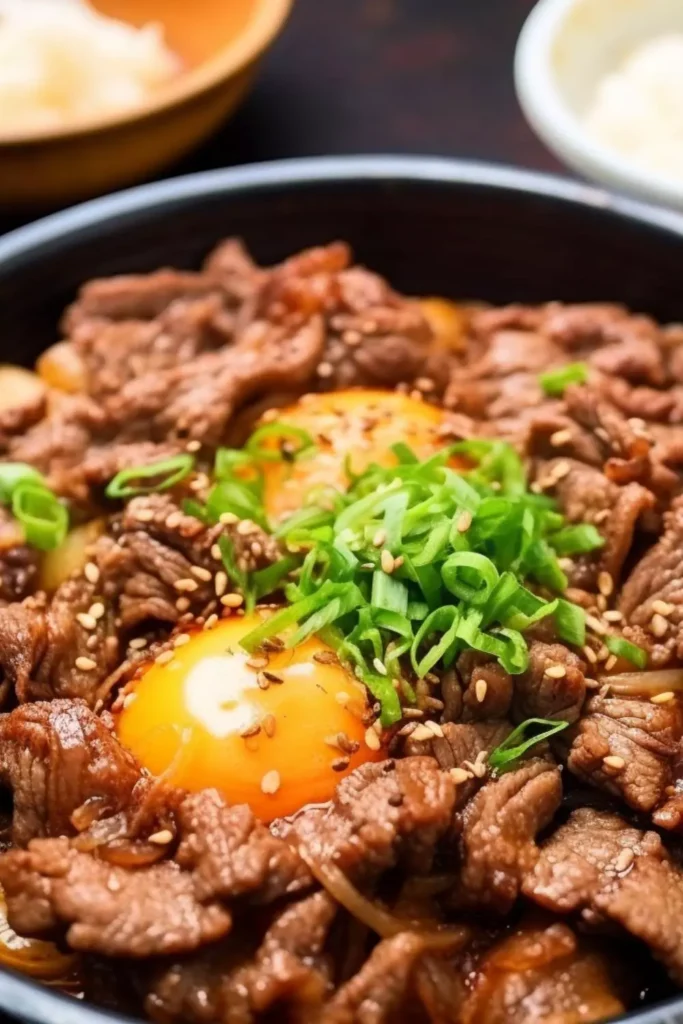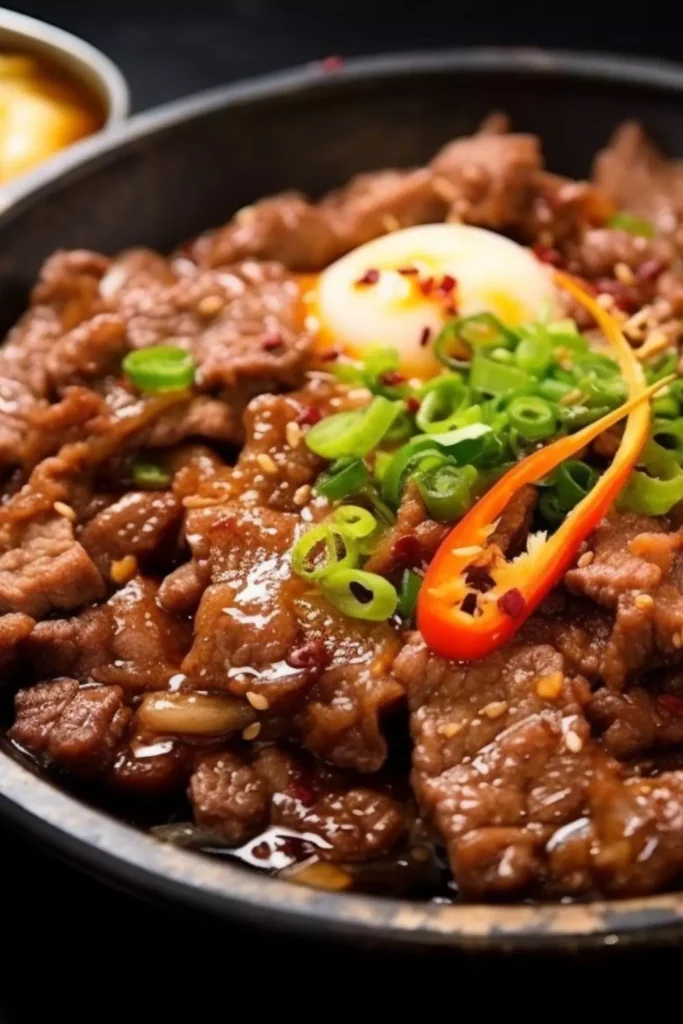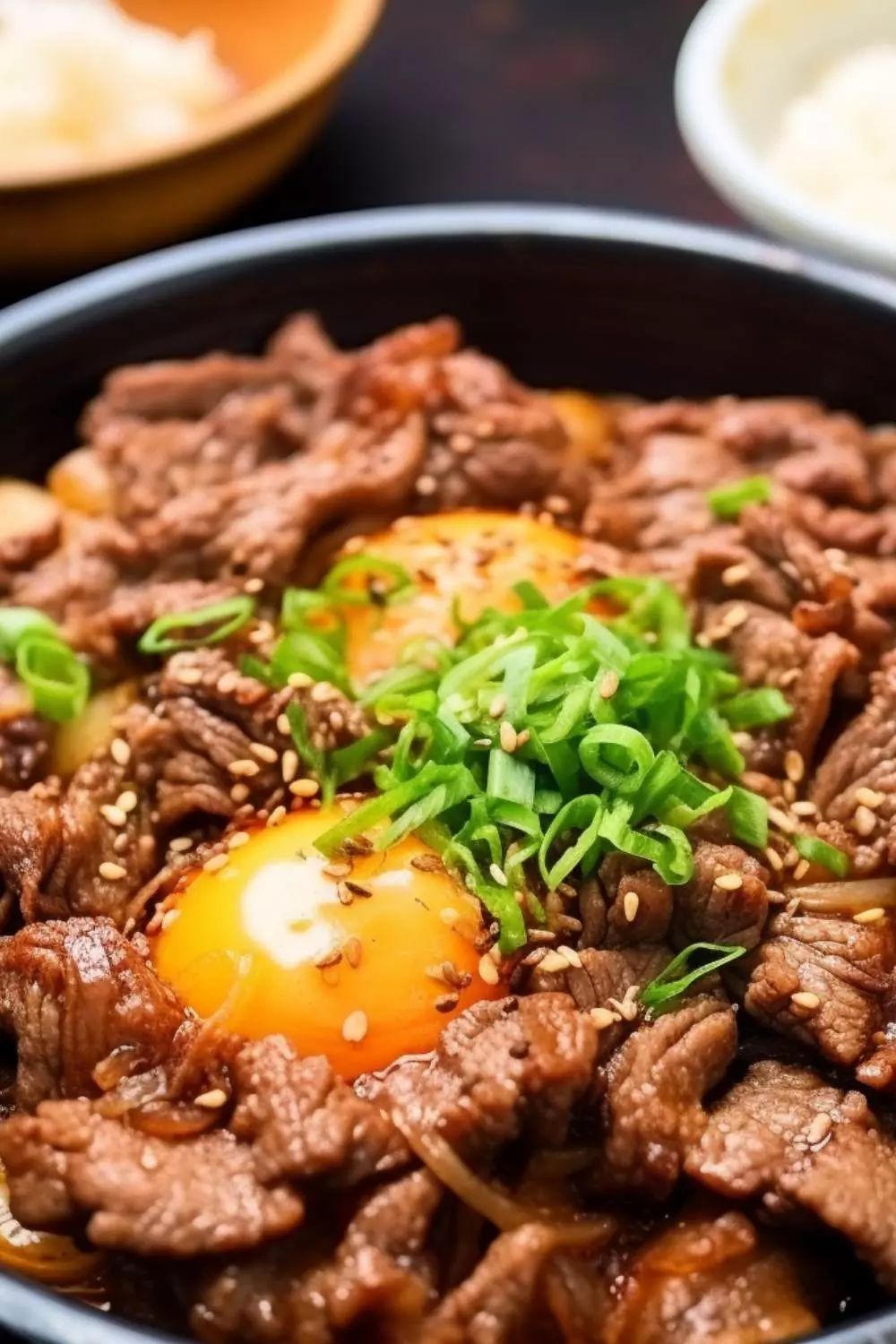Beef Ojyu is a classic Japanese dish that has been around for centuries. It is a simple yet flavorful dish that is sure to please any palate.
Beef Ojyu is made with thinly sliced beef, cooked in a savory broth, and served with steamed vegetables. This dish is a great way to enjoy a classic Japanese experience in the comfort of your own home.

What is beef ojyu?
The Ojyu, a traditional stacking box used for the New Year’s celebratory meal in Japan. Beef Ojyu is a traditional dish for them. It is made with thinly sliced beef, cooked in a savory broth, and served with steamed vegetables.
The beef is marinated in a blend of soy sauce, mirin, and sake to give it a unique flavor. This dish is usually served with steamed white rice and a side of pickled vegetables. It is often served with a spicy miso dip for extra zing.
Why You’ll Love this beef ojyu recipe?
Beef Ojyu is a delicious and easy to make Japanese dish that is sure to please the whole family. It is a great way to enjoy a classic Japanese experience without having to go out for dinner.
The marinade gives the beef a unique flavor that is sure to have you coming back for more. The dish is also very versatile and can be served with a variety of different vegetables. This dish is also very nutritious and is a great way to get your daily dose of protein.
You’ll also like the following Appetizer recipes!
The Ingredients
2 substantial Vidalia Onions, artfully Sliced: Vidalia onions, known for their sweet and mild flavor, add a distinctive taste to the dish. Slicing them artfully ensures they caramelize well, providing a savory and slightly sweet element.
6 tablespoons of Artisanal Soy Sauce: Soy sauce is a fundamental component in Japanese cuisine, adding a savory and salty umami flavor to the beef. The artisanal variety likely enhances the depth and complexity of the sauce.
1 pound of Delicately Thinly Sliced Beef (Choose sirloin or rib eye for a Gourmet touch): Thinly sliced beef cooks quickly and absorbs the flavors of the sauce. Choosing sirloin or rib eye adds a gourmet touch with their tender and rich qualities.
4 tablespoons of Organic Cane Sugar: Cane sugar adds sweetness to balance the saltiness of the soy sauce, creating a well-rounded and nuanced flavor profile in the sauce.
6 tablespoons of Authentic Mirin (Sweet Rice Wine): Mirin contributes sweetness and a glossy finish to the sauce. It also helps to tenderize the meat and adds a traditional Japanese flavor.
4 tablespoons of Handcrafted Sake (Japanese Rice Wine): Sake not only adds depth and complexity to the sauce but also helps to tenderize the beef. The alcohol content evaporates during cooking, leaving behind a rich flavor.
4 cups of Steamed Japanese Rice: Rice serves as the base for the dish, providing a neutral canvas to absorb the flavorful beef and sauce. The steamed Japanese rice complements the overall Japanese culinary theme.
2 teaspoons of Cold-Pressed Vegetable Oil: Vegetable oil is likely used for sautéing the sliced onions and beef, adding a light and neutral base to cook the ingredients without overpowering the dish with its own flavor.
1 cup of Handcrafted Dashi (Japanese Soup Stock): Dashi is a fundamental component in Japanese cuisine, providing a savory and umami base to the dish. It is often made from ingredients like bonito flakes and kombu seaweed.
4 Elegantly Thinly Sliced Green Onions (if your Culinary Aesthetic Desires): Green onions add freshness, color, and a mild onion flavor to the finished dish, enhancing its visual appeal and providing a subtle crunch.
4 Free-Range Eggs (if a Luxurious Finish is Desired): Adding eggs provides a luxurious touch to the dish. Whether soft-boiled or poached, the runny yolk can add a rich and creamy element to the beef ojyu, elevating it to a more indulgent culinary experience.

Step by Step Instructions
Step 1: Sauté Onions
Heat two teaspoons of vegetable oil in a pan over medium heat. Add the sliced onions and cook them until they caramelize and turn a golden brown color. This process enhances the sweetness and depth of flavor in the dish.
Step 2: Cook Beef
Increase the heat and add the thinly sliced beef to the pan with caramelized onions. Stir-fry the beef until it is cooked through, ensuring that it is evenly browned and flavorful.
Step 3: Prepare Sauce
In a bowl, combine the soy sauce, sugar, mirin, sake, and dashi. This creates a flavorful sauce that will infuse the beef and onions with a perfect balance of savory and sweet notes. Pour this sauce mixture over the beef and onions in the pan.
Step 4: Simmer
Reduce the heat to a simmer and allow the beef and onion mixture to cook until the sauce thickens and coats the ingredients beautifully. This simmering process allows the flavors to meld, creating a rich and savory sauce that complements the beef and onions.
Step 5: Fry Eggs (Optional)
In another pan, fry the eggs sunny-side up or as desired. This optional step adds a luscious and creamy element to the dish. The runny yolk can further enrich the flavors when mixed with the rice and beef.
Step 6: Serve
Dish out the cooked Japanese rice into bowls. Top each bowl with the beef and onion mixture, ensuring that the flavorful sauce is generously distributed. Optionally, add a fried egg on top of each serving for added richness and visual appeal. Garnish with thinly sliced green onions for an extra layer of flavor and a touch of freshness.
Notes
• Marinating the beef in the soy sauce mixture before cooking will help to give the dish a unique flavor.
• Adding the dried seaweed flakes to the broth will give the dish a nice crunch.
• Letting the broth simmer for a few minutes will help to thicken it up and give it a more flavorful consistency.
• If you don’t have mirin, you can use a combination of rice vinegar and sugar.
• If you don’t have sake, you can use dry white wine.

Nutrition Information
The nutrition information for this dish is as follows:
Calories: 250
Total Fat: 10g
Saturated Fat: 2g
Cholesterol: 50mg
Sodium: 890 mg
Total Carbohydrates: 10g
Dietary Fiber: 0g
Sugar: 8g
Protein: 25g
How to store beef ojyu recipe?
Beef Ojyu can be stored in the refrigerator for up to four days. Make sure to store it in an airtight container and consume it within this time period. You can also freeze the dish for up to three months. When ready to eat, thaw the dish in the refrigerator overnight before reheating.
Variations
• For a spicy twist, add a few tablespoons of chili garlic sauce to the marinade.
• For a vegetarian version, use tofu instead of beef.
• For a sweet and sour flavor, add a few tablespoons of honey to the marinade.
• For a more savory dish, add mushrooms to the broth.
• For a healthier version, use low-sodium soy sauce and substitute brown sugar for the white sugar.

Equipment
- Bowl
- Pan
Ingredients
- 2 substantial Vidalia Onions artfully Sliced
- 6 tablespoons of Artisanal Soy Sauce
- 1 pound of Delicately Thinly Sliced Beef Choose sirloin or rib eye for a Gourmet touch
- 4 tablespoons of Organic Cane Sugar
- 6 tablespoons of Authentic Mirin Sweet Rice Wine
- 4 tablespoons of Handcrafted Sake Japanese Rice Wine
- 4 cups of Steamed Japanese Rice
- 2 teaspoons of Cold-Pressed Vegetable Oil
- 1 cup of Handcrafted Dashi Japanese Soup Stock
- 4 Elegantly Thinly Sliced Green Onions if your Culinary Aesthetic Desires
- 4 Free-Range Eggs if a Luxurious Finish is Desired
Instructions
- Heat two teaspoons of vegetable oil in a pan over medium heat. Add the sliced onions and cook until they caramelize and turn golden brown.
- Increase the heat and add the thinly sliced beef to the pan. Stir-fry until the beef is cooked through.
- In a bowl, combine the soy sauce, sugar, mirin, sake, and dashi. Pour this mixture over the beef and onions in the pan.
- Reduce the heat and simmer the beef and onion mixture until the sauce thickens and coats the ingredients beautifully.
- In another pan, fry the eggs sunny-side up or as desired.
- Dish out the cooked Japanese rice into bowls. Top each bowl with the beef and onion mixture. Optionally, add a fried egg on top of each serving and garnish with thinly sliced green onions for extra flavor and presentation.
Notes
- Marinating the beef in the soy sauce mixture before cooking will help to give the dish a unique flavor.
- Adding the dried seaweed flakes to the broth will give the dish a nice crunch.
- Letting the broth simmer for a few minutes will help to thicken it up and give it a more flavorful consistency.
- If you don’t have mirin, you can use a combination of rice vinegar and sugar.
- If you don’t have sake, you can use dry white wine.
Nutrition
Frequently Asked Questions
Q: What is the best type of beef to use for beef ojyu?
The best type of beef to use for beef ojyu is thinly sliced beef such as ribeye or sirloin.
Q: How long should the beef marinate?
The beef should marinate for at least 30 minutes.
Q: Can I use a different type of wine instead of sake?
Yes, you can use dry white wine instead of sake.
Q: Is beef ojyu spicy?
No, beef ojyu is not generally spicy. However, you can add chili garlic sauce to the marinade for a spicier version.
Q: Can I use other vegetables instead of steamed vegetables?
Yes, you can use any type of vegetables you like.
Q: Can I freeze beef ojyu?
Yes, you can freeze beef ojyu for up to three months. Make sure to thaw it in the refrigerator before reheating.
Q: What type of pickled vegetables should I use?
A: Any type of pickled vegetables will work for this dish. Popular options include cucumbers, radishes, and carrots.
Conclusion
Beef Ojyu is a classic Japanese dish that has been around for centuries. It is a simple yet flavorful dish that is sure to please any palate. The marinade gives the beef a unique flavor that is sure to have you coming back for more.
This dish is also very versatile and can be served with a variety of different vegetables. Beef Ojyu is a great way to enjoy a classic Japanese experience in the comfort of your own home.
You’ll also like these latest recipes!

Rebecca Novak is a trained chef with over 10 years of experience in the food industry. She has worked in both fine dining and casual Hungarian restaurants and specializes in creating dishes using fresh, seasonal ingredients. She also loves exploring different cuisines worldwide, which allows her to bring unique flavors and ideas to the recipes she creates for Hungarianchef.com. Read more
